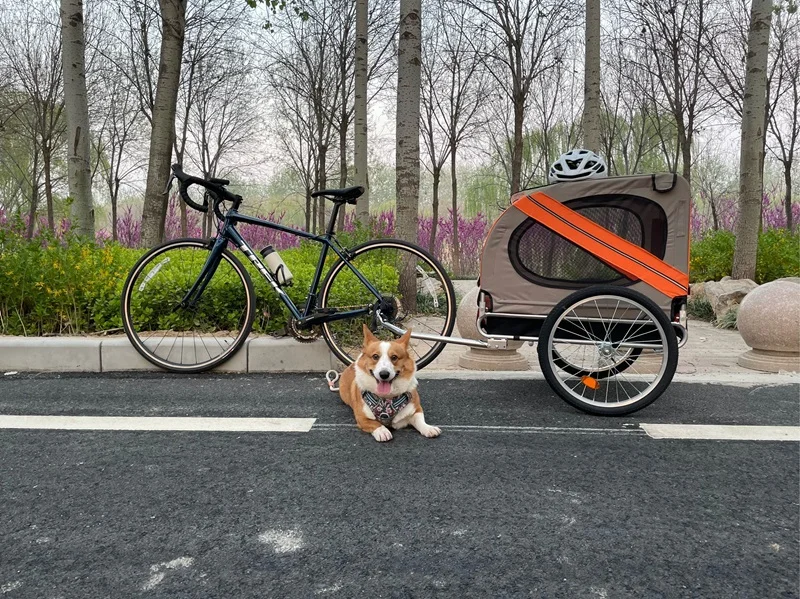Most dogs enjoy being with their owners while they ride a bike. It’s an exhilarating experience that allows them to burn off energy, explore new surroundings, and spend quality time with their human companions. If you have an active and energetic dog, biking together can be a fantastic way to keep both of you fit and engaged. However, it’s important to ensure the safety and comfort of your dog during these biking adventures.
1. Ways to Carry Your Dog on a Bike:
When it comes to bringing your pup along for a bike ride, there are a few options that have worked wonders for me:
a. Bike Baskets:
When choosing a bike basket, consider the size and weight of your dog. Look for a basket that provides enough space for your dog to sit or lie down comfortably. Ensure that the basket is securely attached to your bike’s handlebars or rear rack for stability. Some baskets also come with safety features like leash attachments or covers to keep your dog secure.
b. Bike Trailers:
If you have a larger dog or a dog that may not be able to keep up with the pace of your bike, a bike trailer can be an excellent option. Look for a trailer that is sturdy, well-ventilated, and has a low center of gravity for better stability. Check the weight limit of the trailer to ensure it can accommodate your dog comfortably. Additionally, choose a trailer with a reliable hitch mechanism that securely attaches to your bike.
c. Bike Leash Attachments:
For active dogs that enjoy running alongside you, bike leash attachments provide a great option. These attachments typically consist of a harness or a leash system that connects to your bike’s frame, allowing your dog to run safely at your side. Look for a leash attachment that is adjustable, durable, and provides a comfortable fit for your dog. It’s essential to maintain control and ensure the leash is securely attached to prevent any accidents during the ride.
2. How to Keep Safe During Biking:
a. Proper Equipment:
Invest in a well-fitted harness or biking-specific dog leash system that allows your dog freedom of movement while keeping them secure. Look for reflective materials on the harness or leash to enhance visibility, especially during low-light conditions.
b. Training and Commands:
Before hitting the trails, ensure your dog is well-trained in basic commands such as “sit,” “stay,” and “heel.” Practice these commands in various environments to reinforce obedience and control. Additionally, ensure your dog is comfortable with the bike’s presence by introducing them to it gradually, allowing them to sniff and investigate while it’s stationary.
c. Choose Safe Routes:
When planning your biking routes, prioritize paths with minimal vehicle traffic and distractions. Look for designated bike paths, local parks, or nature trails that allow dogs. These routes provide a safer environment for both you and your furry friend to enjoy the ride without unnecessary hazards.
d. Observe Safety Distances:
Maintain a safe distance between your bike and your dog to prevent any accidental contact. This distance will vary depending on your dog’s size and behavior. Keeping the leash loose will help prevent it from becoming tangled in the bike’s wheels or other moving parts.
e. Protective Gear:
Consider your dog’s specific needs based on the terrain and weather conditions. Doggy goggles can protect their eyes from dust, debris, or wind, while booties can safeguard their paws from hot pavement or sharp objects. Use these protective gears as needed to ensure your dog’s comfort and safety.
f. Hydration and Rest:
During breaks, offer your dog water and allow them to rest and cool down. Carry a collapsible water bowl and a sufficient supply of fresh water. Pay attention to signs of fatigue, overheating, or discomfort, and adjust the intensity and duration of your rides accordingly.
3. Conclusion:
Biking with your dog on a leash can be a rewarding experience that strengthens the bond between you and your furry companion. It allows you both to enjoy the outdoors, stay active, and create lasting memories. Remember to prioritize your dog’s safety, comfort, and overall well-being throughout the entire biking journey. Adapt the training techniques, equipment, and routes to suit your dog’s individual needs. With patience, consistency, and a focus on safety, you’ll be well-prepared to embark on exciting biking adventures together. So, gear up, embrace the joy of exploration, and cherish the special moments shared with your four-legged friend as you pedal your way to new horizons!

